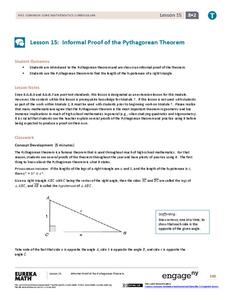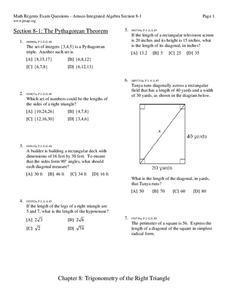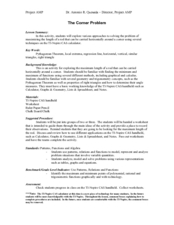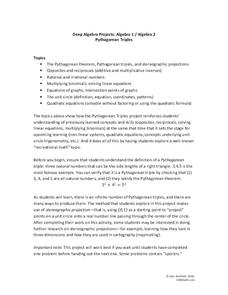Curated OER
Practice Problems
In this geometry worksheet, students practice finding the measure of 4 different angles. Students work independently as they refine their ability to correctly calculate the measure of an angle.
Curated OER
ndirect Measurement Technique: Using Trigonometric Ratios
Ninth graders find the height of an object that would be difficult or impossible to measure directly. They construct and use a Clinometer to measure the angle of elevation (or depression). Students create a sketch of the measurement...
EngageNY
Informal Proof of the Pythagorean Theorem
Prove the Pythagorean Theorem using multiple informal proofs. Scholars first develop an understanding of the origins of the Pythagorean Theorem through proofs. They round out the lesson by using the theorem to find missing side lengths...
CCSS Math Activities
Smarter Balanced Sample Items: High School Math – Target O
Trigger an increased understanding of trigonometry. Young mathematicians answer a set of questions that require finding trigonometric ratios using similarity and solving real-world problems involving trigonometry. The questions all come...
Curated OER
Pythagorean Theorem
Students solve problems using the Pythagorean Theorem. In this geometry lesson plan, students identify the sides and angles of a right triangle. They find the different trigonometric ratios and solve using sine, cosine and tangent.
Curated OER
Indirect Measurement, Surveying Trigonometry
Students measure distances using indirect measurements. In this geometry activity, students apply proportion and ratios to measure heights of different objects. They differentiate between direct and indirect measurements.
Curated OER
Law of Cosines
Students model scenarios using functions and their properties. In this trigonometry lesson, students calculate the angles of sine, cosine and tangent. They perform operation using a calculator.
Curated OER
Exploring Trigonometric Ratios
Students identify the ratios of trig functions. In this trigonometry lesson, students construct triangles and use it to derive the values of sine, cosine and tangent. They use Cabri software to create the visual of the identities.
Curated OER
The Laws of Sines and Cosines Made Simple!
Students explore the concept of law of sines and cosines. In this law of sines and cosines lesson, students construct a triangle tool from card stock and markers. Students use their triangle tool to aid in solving problems involving...
Curated OER
Trigonometric Ratios
Students measure and analyze angles. In this trigonometry lesson, students measure angles and distances use non-traditional techniques. They identify the different ratios of sine, cosine and tangent.
Curated OER
Investigating the Idea of Sin
Fifth graders use sin to solve problems involving right-angled triangles, Solve equations of the form sin(++) = a, for a between -180++ and 360++. They State and graph the value of sin(++) in special cases. They describe some of the ways...
Curated OER
The Tangent Ratio
For this geometry worksheet, learners have to calculate the tangent ratio, given the values of the sides of a triangle. Students should be familiar with basic trig functions. There is an answer key.
Curated OER
The Pythagorean Theorem
In this geometry worksheet, learners solve missing parts of a triangle using the Pythagorean Theorem. There are 19 questions with an answer key.
Curated OER
Whatcha Gunna Do When the Hulkster's Measuring Too??
Students measure using tools they have made. In this algebra lesson, students measure the height and distance using non-traditional measuring methods. They apply their findings to algebra and trigonometry properties of measurements.
Curated OER
The Corner Problem
Young scholars explore the concept of the corner problem. In this corner problem lesson, students use the TI-NSpire to determine the maximum length a rod can be and still pass horizontally around a corner. Young scholars use similar...
Curated OER
Dizzy Heights
Fifth graders explore ways to measure the height of an inaccessible object. They measure lengths using a tape measure or ruler. Students measure angles using a protractor and estimate heights.
Curated OER
The Unit Circle
Students solve problems using the unit circle. In this precalculus lesson, students identify angles using the properties of the unit circle. They observe the trigonometric graphs and sine, cosine and tangent.
Curated OER
Trigonometric Functions of Special Angles
Students explore the concept of the six trigonometric functions, places where the functions can be utilized, and apply these functions to several electrical application problems.
Mathalicious
XBOX Xpotential
Touchdown! This is an exponentially insightful lesson that explores the growth of football games with different video game consoles. Class members discuss whether the increase of mergahertz can be described as linear or exponential. The...
Mathalicious
Out of Left Field
A baseball trajectory and a parabola seem to make the best pair in real-world quadratic applications. Here is a current baseball resource with questions, discussions, and explorations regarding a quadratic function and home run...
Mathematics Vision Project
Module 6: Trigonometric Functions
Create trigonometric functions from circles. The first lesson of the module begins by finding coordinates along a circular path created by a Ferris Wheel. As the lessons progress, pupils graph trigonometric functions and relate them to...
EngageNY
Applications of the Pythagorean Theorem
Examine the application of the Pythagorean Theorem in problem-solving questions. Pupils apply the theorem to find lengths when given different scenarios. They finish the 17th installment in an 18-part series by applying the theorem to...
EngageNY
Ptolemy's Theorem
Everyone's heard of Pythagoras, but who's Ptolemy? Learners test Ptolemy's Theorem using a specific cyclic quadrilateral and a ruler in the 22nd installment of a 23-part module. They then work through a proof of the theorem.
5280 Math
Pythagorean Triples
From Pythagorean triples to the unit circle. Learners use the Pythagorean Theorem to find Pythagorean triples and then relate their work to the unit circle in a fun algebra project. Their discovery that x^2+y^2 is always equal to one on...

























